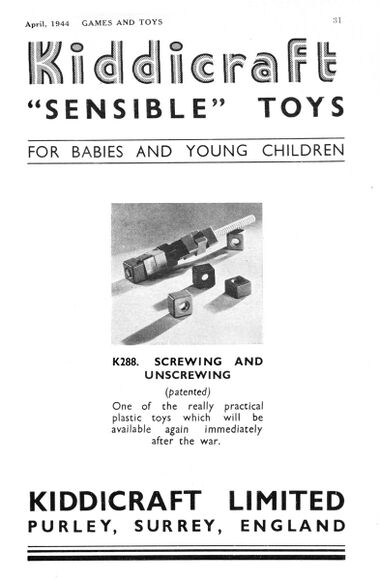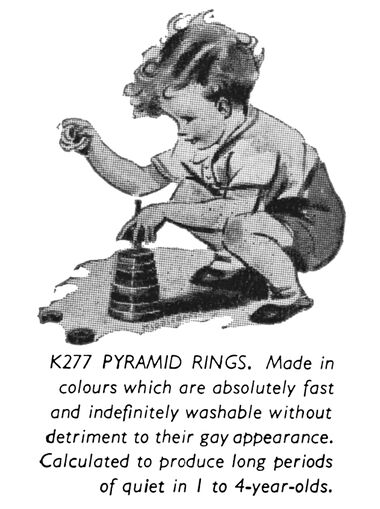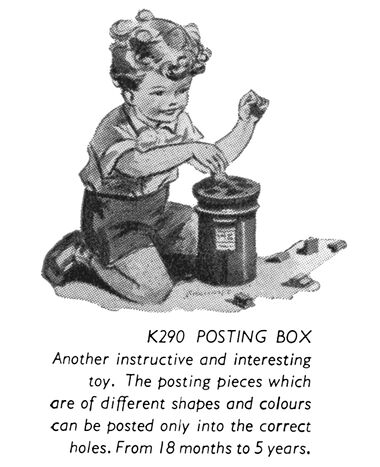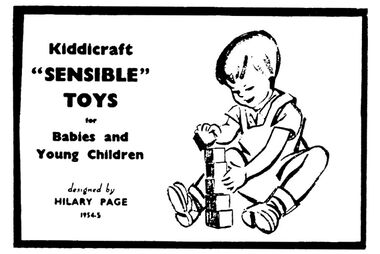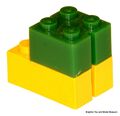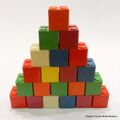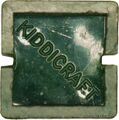Category:Kiddicraft
| Toy Brands and Manufacturers |
|---|
Kiddicraft |
| 1932 - |
1944: Kiddicraft "Sensible" Toys advert, April 1944 [image info]
1955: Kiddicraft K277 Pyramid Rings [image info]
1955: Kiddicraft K290 Posting Box [image info]
1956: Kiddicraft "Sensible Toys", designed by Hilary Page, trade advert [image info]
Kiddicraft's construction bricks [image info]
Kiddicraft was started by Hilary Page in 1932. The brandname was later used by Fisher-Price.
Hilary Page
Hilary Page's family owned a lumber yard, and his initial forays into toymaking revolved around wood, and around importing "educational" wooden toys from abroad that could stimulate the development of the child's brain, such as nesting hollow wooden cubes and shapes that could be stacked together and pulled apart.
Although some of this territory had already been explored by Friedrich Fröbel, Page set himself a mission to redesign children's toys scientifically to create the ultimate range of children's educational toys, not just by imposing abstract concepts of how children ought to understand shape and function, but by spending time in kindergartens watching how children actually played in real life. Page's studies left him slightly horrified – children gnawed on the corners of painted wooden toys, ingested paint and primers and wood-treatment chemicals, and left the toys with rough, chewed, wet surfaces that bred bacteria. As a result of his research, he decided that it would be better if wooden toys designed for pre-schoolers were replaced by the new plastics. The new materials allowed Page's "Sensible Toys" to be brightly coloured, non-toxic, hygienic and and unpainted, and they could be sterilised in boiling water without damage.
1955 retailer "trade" promotional text:
strictly according to the book
It's open to discussion whether the Fothergills arent perhaps a mite over-conscientious in the upbringing of their children. Perhaps it's going too far to have placed such a wide variety of toys on the "banned" list – to insist that each and every plaything must fulfill some positive purpose. But the Fothergills are a business reality to be reckoned with – and for the Fothergills the milestones in the children's progress will forever be linked with the purchase of an unending succession of KIDDICRAFT 'Sensible' TOYS which never fail to inspire an almost fanatical devotion.
You earn "full marks" with the Fothergills if you're a retailer who can always show them a full range of KIDDICRAFT 'Sensible' TOYS – and to judge by KIDDICRAFT sales, there must be an awful lot of Fothergills about.— , Kiddicraft, , British Playthings Overseas, , 1955
Products:
"Cube" blocks
Page started with "Kiddie" nursery toys, and when it came time to design a replacement for the traditional wooden building block his preferred approach of using injection moulding meant that the resulting blocks were lightweight but had an open base, and this meant that in order to be easily and reliably stacked, the blocks needed to have protrusions on their upper surfaces.
The early Interlocking Building Cubes (Kiddicraft) were still basically cube-shaped, with rounded vertical edges and came in a set of different colours moulded from a Bakelite-like material. However, the blocks didn't mate together especially well due to inflexibility of the material and inaccuracies of the moulding process, and Page needed to use the new precision injection moulding processes and experiment with better and more suitable plastics.
"Self-Locking Building Bricks"
As Page continued to develop the concept (patenting his developments along the way), he decided that it would be useful to have a smaller version of these stacking, interlocking blocks, but shaped roughly like UK housebricks so that older children could create model buildings using techniques used in conventional British brick-built houses.
Page developed what we'd now recognise as the outline of the modern Lego brick, but with additional slots cut in two end walls to allow the brick walls a greater degree of flexibility when clipped together. Since the system was still partly experimental, these slots let the brick bases act more like spring-clips, and gave Page an extra level of protection from the effects of tiny changes due to manufacturing tolerances and variations in material that had affected the Building Cubes range.
Page turned these functional slots into "features" – the sets came with doors, windows and shopfront displays printed on card which could be slid into the end-slots, and children's creativity coudl be further encouraged by letting them make their own card add-ons.
The new Kiddicraft "Self-Locking Building Bricks" (1947) had an awkward name, and were targeted at an older age group to Kiddicraft's existing "toddler" range, and the new toys didn't immediately do well.
Kiddicraft Miniatures
Page's next move was to try to restore the company's fortunes by bringing out a massive range of hundreds of dollhouse accessories as collectable miniatures, but before the range could be completed, worries about the company's future got too much for Page, and in 1957 he committed suicide.
Lego
Unknown to Page, the Lego company in Denmark had been shown samples of his designs by an enthusiastic sales rep for a London-based company who wanted to sell Lego an injection moulding machine, and had already copied his patented designs without telling him, had cloned (some would say "stolen") his product, and had been selling it since 1949 (with Page's patented "Self-Locking" brick becoming Lego's "Automatic Binding" brick). The dimensions and proportions of the Danish company's bricks were indistinguishable from Page's, the only real differences being that was that the Danish company used perfectly sharp edges where Page had "softened" his with a slight rounding, and that Page had also rounded the tops of his pegs to aid location, while the "copy" flattened the tops and used them to display a company logo. And, of course, had removed Page's patent notice on the underside.
Lego started selling their products in Britain in 1959.
Lego's version of the design continued to be refined, notably by the removal of the side-slots and the addition of extra extruded detail in the centre of the brick to improve grippage. Lego went on to become known as the world's most successful toy, but Page, the guy who put in the years of research and development to create the concept, research the materials and create the perfect shape and size, never got to see its success.
Addresses
- Kiddicraft Limited – Purley, Surrey, England – (1944)
- Liddicraft Limited – Kenley, Surrey, England – (1945)
france:
- Kiddicraft – 19, Rue Turgot, Paris-9, France – (1953)
External links
Subcategories
This category has the following 6 subcategories, out of 6 total.
A
- Automatic Binding Bricks - Lego Mursten (Lego) (1 P, 5 F)
H
I
- Interlocking Building Cubes (Kiddicraft) (1 P, 5 F)
K
- Kiddicraft Miniatures (10 P)
M
- Modern Lego Bricks (Lego) (empty)
S
Pages in category ‘Kiddicraft’
The following 15 pages are in this category, out of 15 total.
B
H
Media in category ‘Kiddicraft’
The following 74 files are in this category, out of 74 total.
- Bakers Shop, Self-Locking Building Bricks (KiddicraftCard 30).jpg 1,586 × 2,200; 2.2 MB
- Bathroom, Self-Locking Building Bricks (KiddicraftCard 38).jpg 1,586 × 2,200; 2.34 MB
- Bedroom Suite, Self-Locking Building Bricks (KiddicraftCard 19).jpg 1,586 × 2,200; 2.28 MB
- Bookcase, Self-Locking Building Bricks (KiddicraftCard 10).jpg 1,586 × 2,200; 2.42 MB
- Box lid label, Kiddicraft Self-Locking Building Bricks, No1 Set (~1947).jpg 3,000 × 1,773; 2.12 MB
- Bridge, Self-Locking Building Bricks (KiddicraftCard 08).jpg 1,586 × 2,200; 2.43 MB
- Cafe, Self-Locking Building Bricks (KiddicraftCard 05).jpg 1,586 × 2,200; 2.16 MB
- Church, Self-Locking Building Bricks (KiddicraftCard 37).jpg 1,586 × 2,200; 2.64 MB
- Clock Tower, Self-Locking Building Bricks (KiddicraftCard 09).jpg 1,586 × 2,200; 2.57 MB
- Clock, Self-Locking Building Bricks (KiddicraftCard 01).jpg 1,586 × 2,200; 2.23 MB
- Crane, Self-Locking Building Bricks (KiddicraftCard 17).jpg 1,586 × 2,200; 2.13 MB
- Dovecote, Self-Locking Building Bricks (KiddicraftCard 27).jpg 1,586 × 2,200; 2.3 MB
- Drawing Room Suite, Self-Locking Building Bricks (KiddicraftCard 14).jpg 1,586 × 2,200; 2.31 MB
- Dresser, Self-Locking Building Bricks (KiddicraftCard 12).jpg 1,586 × 2,200; 2.32 MB
- Engine, Self-Locking Building Bricks (KiddicraftCard 40).jpg 1,586 × 2,200; 2.39 MB
- Fire Station, Self-Locking Building Bricks (KiddicraftCard 22).jpg 1,586 × 2,200; 2.09 MB
- Fireplace Bookcase and Chair, Self-Locking Building Bricks (KiddicraftCard 13).jpg 1,586 × 2,200; 2.25 MB
- Garage, Self-Locking Building Bricks (KiddicraftCard 11).jpg 1,586 × 2,200; 2.38 MB
- Gas Cooker, Self-Locking Building Bricks (KiddicraftCard 23).jpg 1,586 × 2,200; 2.12 MB
- Greenhouse, Self-Locking Building Bricks (KiddicraftCard 45).jpg 1,586 × 2,200; 2.38 MB
- Grocers Shop, Self-Locking Building Bricks (KiddicraftCard 15).jpg 1,586 × 2,200; 2.09 MB
- Gun, Self-Locking Building Bricks (KiddicraftCard 42).jpg 1,586 × 2,200; 2.36 MB
- Hilary Page patent 633055 01 (1945-1949).jpg 1,225 × 1,933; 320 KB
- Hilary Page patent 633055 02 (1945-1949).jpg 1,227 × 1,897; 217 KB
- Hilary Page patent GB529580 (1939-1940).jpg 1,207 × 2,007; 254 KB
- Hilary Page patent GB587206 (1944-1947).jpg 1,247 × 2,025; 335 KB
- Hilary Page patent GB673857 (1949-1950).jpg 1,399 × 2,200; 460 KB
- House and Garage, Self-Locking Building Bricks (KiddicraftCard 35).jpg 1,586 × 2,200; 2.51 MB
- House with Annex, Self-Locking Building Bricks (KiddicraftCard 39).jpg 1,586 × 2,200; 2.29 MB
- House with Bay Window, Self-Locking Building Bricks (KiddicraftCard 16).jpg 1,586 × 2,200; 2.22 MB
- House with Gable, Self-Locking Building Bricks (KiddicraftCard 26).jpg 1,586 × 2,200; 2.24 MB
- Inner box contents label, Self-Locking Building Bricks, Set No1 (Kiddicraft ~1947).jpg 1,857 × 2,500; 1.79 MB
- Kiddicraft and Lego bricks.jpg 675 × 500; 49 KB
- Kiddicraft base black detail.jpg 1,024 × 768; 75 KB
- Kiddicraft base black.jpg 1,200 × 1,200; 103 KB
- Kiddicraft brick (green) and Lego Mursten brick (yellow).jpg 1,600 × 1,548; 147 KB
- Kiddicraft Bricks card37 church.jpg 768 × 1,024; 51 KB
- Kiddicraft Bricks Injection Moulders Ltd.jpg 380 × 240; 11 KB
- Kiddicraft Bricks introcard.jpg 467 × 650; 51 KB
- Kiddicraft diagram slots.jpg 768 × 1,024; 57 KB
- Kiddicraft Interlocking Building Cubes, innards.jpg 1,200 × 900; 527 KB
- Kiddicraft Interlocking Building Cubes, loose.jpg 1,200 × 900; 588 KB
- Kiddicraft Interlocking Building Cubes, stacked.jpg 1,200 × 1,200; 57 KB
- Kiddicraft Self-Locking Building Bricks, assembled house.jpg 1,200 × 900; 670 KB
- Kiddicraft Sensible Toys (GaT 1944-04).jpg 786 × 1,200; 96 KB
- Kiddicraft Sensible Toys, Designed by Hilary Page (BPO 1955-10).jpg 2,500 × 500; 191 KB
- Kiddicraft windows.jpg 497 × 226; 32 KB
- Lioness in Cage, Self-Locking Building Bricks (KiddicraftCard 06).jpg 1,586 × 2,200; 2.69 MB
- Man and Woman, Self-Locking Building Bricks (KiddicraftCard 02).jpg 1,586 × 2,200; 2.24 MB
- Man on a Chair, Self-Locking Building Bricks (KiddicraftCard 07).jpg 1,586 × 2,200; 2.12 MB
- Piano and Stool, Self-Locking Building Bricks (KiddicraftCard 21).jpg 1,586 × 2,200; 2.21 MB
- Pillar Box, Self-Locking Building Bricks (KiddicraftCard 41).jpg 1,586 × 2,200; 2.14 MB
- Post Office, Self-Locking Building Bricks (KiddicraftCard 03).jpg 1,586 × 2,200; 2.31 MB
- Posting Box, Kiddicraft K290 (BPO 1955-10).jpg 1,138 × 1,398; 424 KB
- Pyramid Rings, Kiddicraft K277 (BPO 1955-10).jpg 1,018 × 1,364; 420 KB
- Rabbit Hutch, Self-Locking Building Bricks (KiddicraftCard 18).jpg 1,586 × 2,200; 2.15 MB
- Radio and Table, Self-Locking Building Bricks (KiddicraftCard 29).jpg 1,586 × 2,200; 2.28 MB
- Refrigerator, Self-Locking Building Bricks (KiddicraftCard 04).jpg 1,586 × 2,200; 2.29 MB
- Self-Locking Building Bricks, 2x2 underside (Kiddicraft 1947).jpg 1,231 × 1,241; 193 KB
- Self-Locking Building Bricks, Kiddicraft K299-K304 (BPO 1955-10).jpg 950 × 1,186; 324 KB
- Sensible Toys, Kiddicraft (BPO 1955-10).jpg 819 × 1,200; 355 KB
- Sensible Toys, Kiddicraft Ltd (GaT 1956).jpg 1,138 × 761; 96 KB
- Signal Box, Self-Locking Building Bricks (KiddicraftCard 25).jpg 1,586 × 2,200; 2.26 MB
- Stables, Self-Locking Building Bricks (KiddicraftCard 20).jpg 1,586 × 2,200; 2.61 MB
- Steamer, Self-Locking Building Bricks (KiddicraftCard 32).jpg 1,586 × 2,200; 2.17 MB
- Submarine, Self-Locking Building Bricks (KiddicraftCard 31).jpg 1,586 × 2,200; 2.27 MB
- Sweet Shop, Self-Locking Building Bricks (KiddicraftCard 24).jpg 1,586 × 2,200; 2.47 MB
- Tank, Self-Locking Building Bricks (KiddicraftCard 43).jpg 1,586 × 2,200; 2.22 MB
- Truck, Self-Locking Building Bricks (KiddicraftCard 44).jpg 1,586 × 2,200; 2.31 MB
- Two Chairs and a Table, Self-Locking Building Bricks (KiddicraftCard 28).jpg 1,586 × 2,200; 2.33 MB
- Two-Storey House, Self-Locking Building Bricks (KiddicraftCard 34).jpg 1,586 × 2,200; 2.21 MB
- Windmill, Self-Locking Building Bricks (KiddicraftCard 33).jpg 1,586 × 2,200; 2.44 MB
- Writing Desk and Chair, Self-Locking Building Bricks (KiddicraftCard 36).jpg 1,586 × 2,200; 2.61 MB

